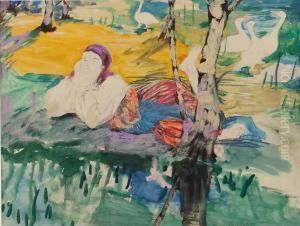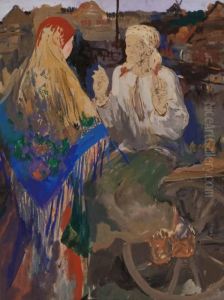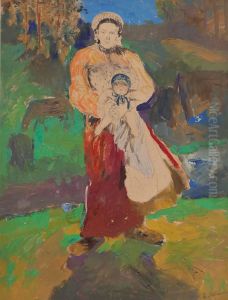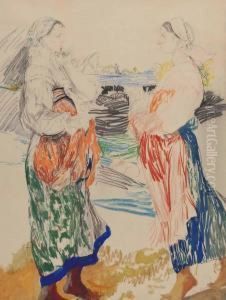Philipp Andrejewitsch Malyavin Paintings
Philipp Andrejewitsch Malyavin was a Russian painter and graphic artist, born on October 6, 1869, in the village of Kazanki, in what was then the Russian Empire. He grew up in a peasant family, and his early life was defined by the rural and religious traditions of the Russian countryside, which would later greatly influence his art.
Malyavin's artistic talent was evident from a young age, but his path to becoming an artist was not straightforward. Having initially trained to join the priesthood, his life took a dramatic turn when he was discovered by the prominent realist painter Ilya Repin. Repin recognized Malyavin's raw talent and encouraged him to attend the Moscow School of Painting, Sculpture and Architecture. However, due to Malyavin's lack of formal education, he was not admitted, leading him to study at the Imperial Academy of Arts in St. Petersburg, where he was finally accepted in 1891.
Malyavin's time at the Academy was marked by both success and rebellion. While he won awards and recognition, including a scholarship to study abroad, his individualistic style and preference for peasant subjects often clashed with the academic standards of the time. His most famous work from this period, 'Whirlwind', showcasing vibrant, swirling peasant women, broke from tradition and garnered mixed reactions from the public and critics.
After his time at the Academy, Malyavin continued to develop his distinctive style, which blended elements of Russian folk art with the expressive power of the European modernist movements. His paintings are characterized by their bold use of color, dynamic composition, and the emotive portrayal of his subjects, often peasant women and the rural life of Russia.
Malyavin's career progressed amidst the backdrop of significant political and social change in Russia. The 1917 Russian Revolution eventually led to a difficult period for the artist. With the rise of the Soviet Union and its restrictive policies towards art, Malyavin found himself increasingly at odds with the new government's artistic ideology. In 1922, he left Russia and eventually settled in France, where he lived and worked until his death on December 23, 1940.
In exile, Malyavin continued to paint, though he never achieved the same level of success he enjoyed in Russia. His work during this period often reflected a sense of nostalgia for his homeland. Despite the challenges he faced, Malyavin's legacy as a unique and passionate chronicler of Russian peasant life endures, and his work is celebrated for its vibrant energy and cultural significance.



